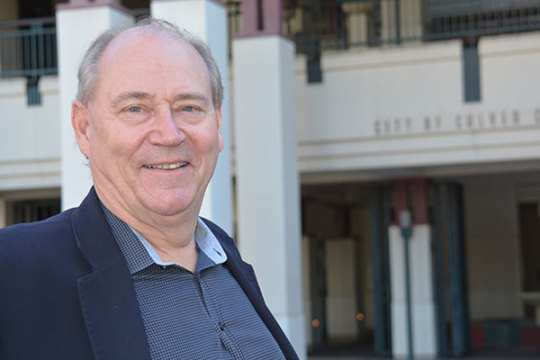
Candidate campaign page: http://www.erikssonforcouncil.com/
Göran Eriksson presents a strong, bike-friendly platform through support for a Vision Zero policy in Culver City, support for a bike share system, and the need to provide access to transit for bicycle commuters, particularly between the Expo Line and Downtown Culver City. As a Culver City Chamber of Commerce board member, there’s no doubt that Mr. Eriksson understands the ways in which a connected, safe, and convenient network for bicycle transportation helps local businesses and the local economy. We were troubled by Mr. Eriksson’s support for removing crosswalks on Jefferson Blvd, where we would prefer to see priority placed on the mobility needs of local residents aiming to commute and/or get exercise on foot. We also would like to see more prioritization and urgency from Mr. Eriksson for bicycle infrastructure, including making the sometimes difficult decision to reallocate roadway space to make it safer to bike and walk. But we have faith that Mr. Eriksson’s vision for a safe and convenient transportation system – and his knowledge of European models for bicycle infrastructure – will make him a thoughtful advocate on the City Council of a more bikeable and safer Culver City.
Bike The Vote L.A. 2016 Grade: B+
(See below for full candidate questionnaire response)
1. What would an ideal transportation system for Culver City consist of? What mode options, considerations for people of different ages and abilities, and innovative features would that transportation system include?
Eriksson: The ideal system would be a public transportation system that was commuter-oriented, coordinating bus and light rail schedules so that rider could count on efficient and timely transportation to and from their destinations. Today, we have a rail system and a bus system, but they act largely independently. We need to have them work together seamlessly as part of a multi-modal transportation network. Taking that a step further, we must develop an extensive system of dedicated/separated bike/walk paths to connect with the Expo Line, our main commercial areas, residential neighborhoods and schools. In short, we must make it easy, reliable and timely for commuters and recreational users to go from their front door to their destination by using some combination of walking, biking and public transportation. I am also a proponent of a bike- and/or car-share program throughout Culver City to provide added flexibility. In addition, I believe the blossoming of the sharing economy gives us the opportunity to provide incentives for services like Uber and Lyft to drop and pick up passengers at locations that work best for our system (major transportation hubs, shopping destinations, etc.). That is something the city should explore immediately since it helps both reduce traffic and demand for parking.
2. With so many people on foot and on bike killed each year while commuting in Los Angeles County, the City of Los Angeles recently adopted a “Vision Zero” policy to work towards eliminating traffic deaths in the City of L.A. by 2025. Would you support adopting Vision Zero for Culver City?
Eriksson: Yes.
3. Culver City is considering implementing protected bike lanes – bike lanes separated from vehicles by a physical barrier – in two key locations: 1) on National Blvd to close the gap between the two halves of the Expo Bike Path that extend to USC/Expo Park to the East and Santa Monica to the West, and 2) on Washington Blvd connecting the Expo Line Culver City station to Downtown Culver City. Do you support these projects, which may require a dedication of developer land and/or a reduction of on-street car parking spaces?
Eriksson: I support the creation of dedicated bike paths where possible. Specifically, I believe that a path between the Expo Station and Downtown Culver City should be pursued because it will help make commuting using the light rail safer and more appealing. Looking at how similar pathways have been developed in Europe, I believe that the natural connection between our Downtown and the Expo Station is from the west end (Venice Boulevard side of the station). That is the shortest distance and it is a route that should be explored.
4. Would you support bringing a bike share system to Culver City, and if so, what will you do to expedite its installation?
Eriksson: I believe in a bike-share system, but in order for such a system to be effective in our city, it must be part of a larger, regional system. I believe Culver City can be a leader in working with the City of Los Angeles and Metro to push hard for the establishment of such a system and can work within our city to provide the needed amenities (bike lockers, vending locations for patch kits, etc.) to make it successful.
5. The City Council recently voted to prioritize vehicular travel through Culver City over providing pedestrian access for local residents to businesses and Culver City Park. Do you support the removal of crosswalks at Duquesne & Jefferson and Summertime Lane/Jordan Way & Jefferson?
Eriksson: This is a decision that has already been made by the Council, and while it will increase pedestrian safety at those intersections by minimizing left-turn conflicts with cars, it is important for us to create safe, walkable streets throughout our city. Sometimes that will mean adding crosswalks to facilitate easier crossings for pedestrians and other times it will mean encouraging pedestrians to cross where it is safer for them to do so.
6. Do you presently bike in Culver City? What are your experiences, or if not, what would it take to make you feel comfortable biking on city streets?
Eriksson: I do bike on a regular basis, but I ride primarily on neighborhood streets, Culver Boulevard and the Ballona Creek Bike Path. Like many recreational cyclists, I’m not comfortable riding on streets with lots of traffic (Sepulveda, Overland, Washington, etc.). I, and many others, would ride more if we can find a way to make it safer by creating separated bike paths, something I definitely support.
